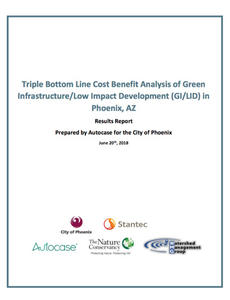Stantec, Autocase, and Watershed Management Group (WMG) were engaged by the City of Phoenix (City) – with The Nature Conservancy (TNC) as a contributing and reviewing partner – to perform a triple bottom line cost benefit analysis (TBL-CBA) of various Green Infrastructure/Low Impact Development (GI/LID) features, as well as look at the triple bottom line impacts of three case study sites in the area.
The TBL-CBA business case was conducted in Autocase - a cloud-based software tool, to provide insights into the net present value (NPV) of costs and benefits of the projects to the City, as well as the broader societal and environmental impacts over a 50-year time horizon using a 3% discount rate to convert all future cash flows into a present value.
TBL-CBA is a systematic evidence-based economic business case framework that uses best practice Life Cycle Cost Analysis and Cost Benefit Analysis (CBA) techniques to quantify and attribute monetary values to the Triple Bottom Line (TBL) impacts resulting from an investment. TBL-CBA expands the traditional financial reporting framework (such as capital, and operations and maintenance costs) to also consider social and environmental performance. TBL-CBA provides an objective, transparent and defensible economic business case approach to assess the costs and benefits pertaining to the project being analyzed.
This study provides information for City projects and private development that may want to implement and incorporate GI/LID facilities. The costs and co-benefits of GI/LID features in the Phoenix environment need to be evaluated to identify the benefits and aid in potentially identifying to which stakeholders they accrue. The City identified key motivating factors for this study, as follows:
- The need to evaluate the following key parameters:
- Financial costs and benefits;
- Carbon emissions and air pollution;
- Heat island impacts;
- Water quality improvement;
- Flood risk reduction;
- Property value uplift.
- The need to identify and ensure a common understanding of benefits vs. initial costs vs. life cycle costs
- The need to provide recommendations on appropriate feature types according to associated costs and benefits.
Given the importance of heat stress in Phoenix, instead of using historical temperatures this report incorporates future climate change in to its analysis. Taking the emissions pathway RCP8.5 “higher emissions” scenario from NOAA’s climate explorer (NOAA, 2018), the analysis incorporates future temperature and rainfall predictions for Maricopa County in to Autocase. In so doing, the results will aid in resilience decision-making related to urban heat island.
Local data were used whenever possible and available; information from various sources, such as EPA’s SUSTAIN database and the National Stormwater Management Calculator was used to supplement any gaps and are identified throughout the report.

